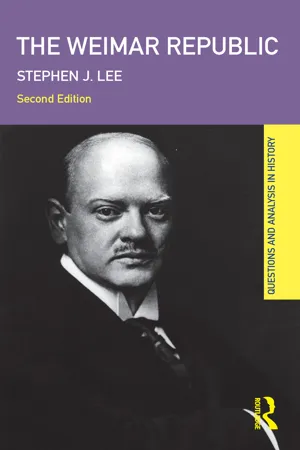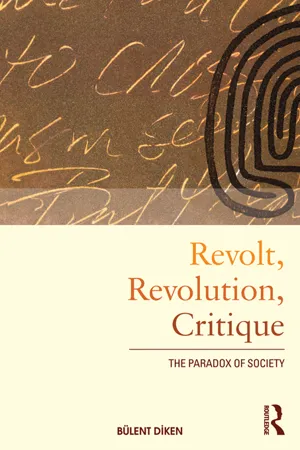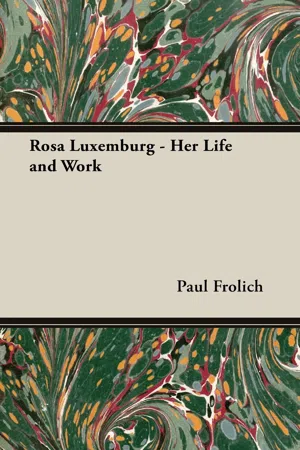History
Spartacist Uprising
The Spartacist Uprising was a major revolt in Germany in January 1919, led by the Spartacus League, a radical socialist group. The uprising aimed to overthrow the Weimar government and establish a communist state. The revolt was brutally suppressed by the government, leading to the deaths of many Spartacist leaders and supporters.
Written by Perlego with AI-assistance
Related key terms
Related key terms
1 of 4
Related key terms
1 of 3
5 Key excerpts on "Spartacist Uprising"
- Jon Nixon(Author)
- 2018(Publication Date)
- Pluto Press(Publisher)
Each of these groupings had different political agendas. ‘The rank and file soldiers,’ as Harman puts it, ‘were fed up with war, hardship, military discipline, with eating miserable rations while their officers feasted in luxury’ (1997: 52). They controlled the soldiers’ and workers’ councils that were springing up spontaneously not only in all the major German towns but also in Belgium and France as well as Russia. The extent to which their broad political aims extended beyond their occupational concerns no doubt varied across townships and regions, but they were a major force in the revolutionary surge of November 1918. Within this developing revolutionary situation, the USPD were compromised by their historic links with the now governing SPD, but nevertheless retained some influence within the emerging councils and maintained intermittent dialogue with the Spartacus League. But the overall situation was fluid in respect of overlapping affiliations and unpredictable in terms of what might happen when and on whose initiative. There was neither a centrally organising body, nor a formally agreed mode of decentralised control.The Spartacus League was the ideological driving force behind the revolutionary surge. It comprised a tightly knit group, whose luminaries included Jogiches, Liebknecht, Luxemburg, Mehring and Clara Zetkin. ‘Its core,’ as Frölich wrote, ‘was the old left-wing of Social Democracy, an elite well-grounded in Marxism and schooled in the tactical ideas of Rosa Luxemburg.’ But the Spartacists also included – or were closely aligned to – what Frölich described as ‘additional elements coming from varied social and political backgrounds who had been driven to the extreme left wing of the working-class movement as a result of their militant opposition to the war’ (Frölich [1939] 2010: 279). Chief among these elements was the Left Radicals, a revolutionary group formed in 1917 and based in Bremen (and with close links to the Bolsheviks through one of its foremost figures, Karl Radek). Although the Spartacists worked in tandem with these elements and with the wider network of workers’ and soldiers’ councils, they operated according to their own organisational principles and had a clearly defined sense of membership – in a letter to Lenin dated 20 December 1918 Luxemburg referred to it as ‘our family’ (R: 486).- eBook - ePub
The Spartacist Uprising of 1919
and the Crisis of the German Socialist Movement
- Eric Waldman(Author)
- 2020(Publication Date)
- Barakaldo Books(Publisher)
Part 3—The Spartacists and the January Uprising
Chapter 5—“The Spartacists and the January Uprising”—Civil War in Berlin
1. The Test of Strength
The hostile encounters between the Majority Socialists and the left opposition during December 1918 had deepened the cleavage within the German socialist movement. Mutual animosity had grown in intensity. The rival demonstrations on December 29, 1918, at the occasion of the funeral for the victims of the Christmas incident, had illustrated the great antagonism existing between the “government” socialists and their opposition on the left. The attitude of the SPD leadership toward the left wing radicals was expressed in a candid article in Vorwaerts :The despicable actions of Liebknecht and Rosa Luxemburg soil the revolution and endanger all of its achievements. The masses must not sit by quietly for one minute longer while these brutal beasts and their followers paralyze the activities of the republican governmental offices, incite the people more and more to a civil war, and strangle with their dirty fists the right of free expression.They want to demolish and destroy with lies, slander, and violence everything which dares oppose them. They pose with boundless insolence as the masters of Berlin, in spite of the fact that at least nine-tenths of the population hate and despise their actions from the bottom of their souls....{351}Middle class circles joined the Majority Socialists in their attacks against the left wing radicals. At the end of December 1918, the so-called “Berlin Citizens’ Council” distributed a leaflet which, in the manner of the SPD, blamed primarily the Spartacists for the unrest and violence.Workers, Soldiers! The Christmas blows of the Spartacist group lead directly into the abyss. None of us wishes to spill blood. However, it is easier to cure a mad dog with biblical phrases than [to change] the Spartacists with gentle persuasion. The brutal force of these criminals can be countered only with force. If they intend to strike us down, we shall defend our skins. The hypocritical outcry of the Spartacists about the “blood bath” does not divert us from their intention to pit workers against workers and soldiers against soldiers. - eBook - ePub
- Stephen J. Lee(Author)
- 2013(Publication Date)
- Routledge(Publisher)
It was no secret, however, that the groups had vastly different aims. The SPD hoped to establish a Western parliamentary system, while the USPD wanted to give pre-eminence to the councils and the Spartacist leaders, Karl Liebknecht and Rosa Luxemburg, intended to emulate the Bolshevik Revolution in Russia. In January 1919, the Spartacists came out in open revolt in the streets of Berlin. They were, however, crushed by the Freikorps, or remnants of the Imperial army, with the full knowledge and sanction of Ebert, who had already done a deal with the commanding officer, General Groener. The next target was Bavaria, which had in the meantime proclaimed a Soviet Republic: this regime was brought down by the Freikorps in April 1919. Meanwhile, elections had been held for the convening of the first full assembly of the Republic. This met in Weimar but, once violence in Berlin had ended, the legislature was transferred back to Berlin, which once again became the permanent capital. ANALYSIS 1: EXPLAIN THE POLITICAL CONFLICT IN GERMANY BETWEEN 1914 AND 1919 At the end of 1918 and the beginning of 1919 Germany experienced major political changes. The first stage occurred in October 1918 when the military dictatorship under Ludendorff handed over power to a constitutional government under Prince Max of Baden. Then, on 9 November, the Kaiser’s regime collapsed altogether, to be replaced by a Republic. This, in turn, experienced internal upheaval as the various factions of the political left contested power against in each other in Berlin and elsewhere. Even before 1914, the long-term political stability of the Kaiser’s Reich had been threatened by two deep faultlines. One was the potential for conflict between the authoritarian base of the Reich and the constitutional challenges of frustrated liberalism, especially apparent in the middle classes - eBook - ePub
Revolt, Revolution, Critique
The Paradox of Society
- Bulent Diken(Author)
- 2012(Publication Date)
- Routledge(Publisher)
But they are constantly confusing two different things, the way revolutions turn out historically and people’s revolutionary becoming. These relate to two different sets of people. Men’s only hope lies in a revolutionary becoming: the only way of … responding to what is intolerable.(Deleuze 1995: 171)One way to repress the event is to reduce it to its historical consequences, allowing its virtual aspect to disappear into actual ‘facts’. But there is another, more interesting destination for the subject: repetition in the form of a reappearing, a resurrection. If the faithful subject produces the new present, while the reactive subject refuses it and the obscure subject leads to its occultation, resurrection reactivates the faithful subject in a new context, according to a new logic, ‘forgetting’ the very forgetting (or failure) of the revolt-event (Badiou 2009b: 65): a procedure which says ‘I am Spartacus!’, making ‘Spartacus’ a generic name, common to all those who revolt, like the ‘black Spartacus’ Toussaint-Louverture, the leader of the insurgent black slaves who escaped from plantations and defeated the Napoleonic forces in Haiti in 1796–1804, or like the ‘Spartacist’ leaders of the communist revolt in Germany in 1919. ‘Ancient Spartacus, black Spartacus, red Spartacus’… (ibid.).Most probably, after all, Spartacus objectively knew that he did not have a chance against the Roman army in the long run, which is why his overall strategy was exodus. For one thing, the majority of the slaves in Italy, especially the urban slaves, had not joined his army; the 60,000 rebels made only 4 per cent of the slave population in Italy (Strauss 2009: 2, 41). The rest took a reactionary position, while the Roman proletarii - eBook - ePub
- Paul Frolich(Author)
- 2020(Publication Date)
- Hesperides Press(Publisher)
élite divisions marched into Berlin, but they quickly melted away in the fire of the revolution, and the social-democratic commandant of Berlin, Wels, then founded the Republic Soldiers’ League. It was financed directly by capitalist groups, and totalled about 15,000 men. The military forces on the side of the revolution were weak. The Berlin Police President, Emil Eichhorn, a member of the Independent Social Democratic Party, had formed a security police force out of trade-unionists. The so-called People’s Marine Division, totalling about 3,000 men, was stationed in the old Imperial Palace. It was a politically unreliable body, and for some time it was under the command of Wilhelm II’s old friend, Count Wolff Metternich. There was also a small force of Spartakists organised in the Red Soldiers’ League. However, in addition, many thousands of workers were now armed, and prepared to defend the revolution.On December 6th the counter-revolution ventured its first open action. In Hamburg and the Rhineland counter-revolutionary conspiracies were discovered. In Berlin a group of soldiers “loyal to the government” proclaimed Ebert President of the Republic and demanded that he should take complete power. Another group arrested the Executive Committee of the Workers’ and Soldiers’ Councils, and a third group occupied the offices of the Rote Fahne . In the north of Berlin a demonstration organised by the Red Soldiers’ League with the knowledge and permission of the authorities was fired on under the pretext that a Spartakist Putsch was planned. Eighteen demonstrators were killed and thirty wounded. An investigation instituted by the Police President revealed the fact that all these happenings had a common origin, and all signs indicated that the guilty parties sat in the Berlin Commandant’s office, in the War Ministry, and in the Foreign Office. The happenings shook the prestige of the Government, and, following an appeal by the Spartakus League, hundreds of thousands of workers demonstrated on the streets of Berlin against the machinations of the counter-revolution. However, no direct measures were taken to protect the revolution.The campaign of incitement against Spartakus was now intensified to the pitch of hysteria. Spartakist Putsches were announced every day, “Bolshevism” and “Spartakus” became the bogies of frightened bourgeois everywhere. “Bolshevism nationalises women!” Every crime up and down the country was attributed to Spartakus. Karl Liebknecht, Rosa Luxemburg, and their followers were presented as a horde of murderous and sadistic beasts, and the Anti-Bolshevist League, liberally supplied with Government money, invented new monstrosities every day and sent them out into the world on sensational posters which appeared on walls and hoardings everywhere. Spies and groups of agents-provocateurs were organised, an atmosphere of murder and pogrom was deliberately fomented, and the killing of the Spartakist leaders was openly advocated in public meetings and in the Press. Without interference by the social-democratic authorities the Heimatdienst
Index pages curate the most relevant extracts from our library of academic textbooks. They’ve been created using an in-house natural language model (NLM), each adding context and meaning to key research topics.
Explore more topic indexes
Explore more topic indexes
1 of 6
Explore more topic indexes
1 of 4




